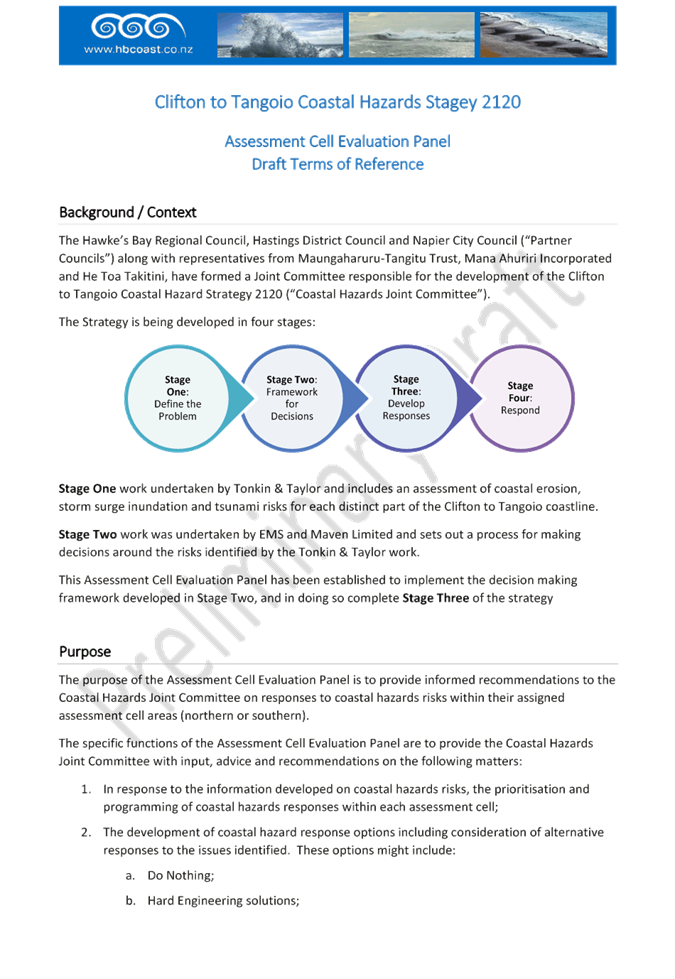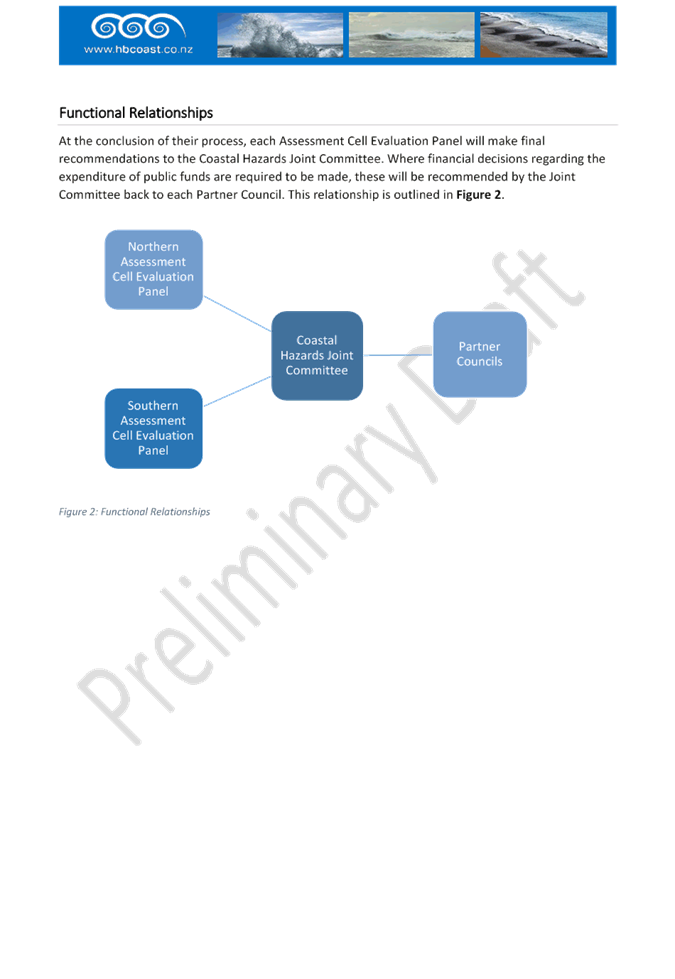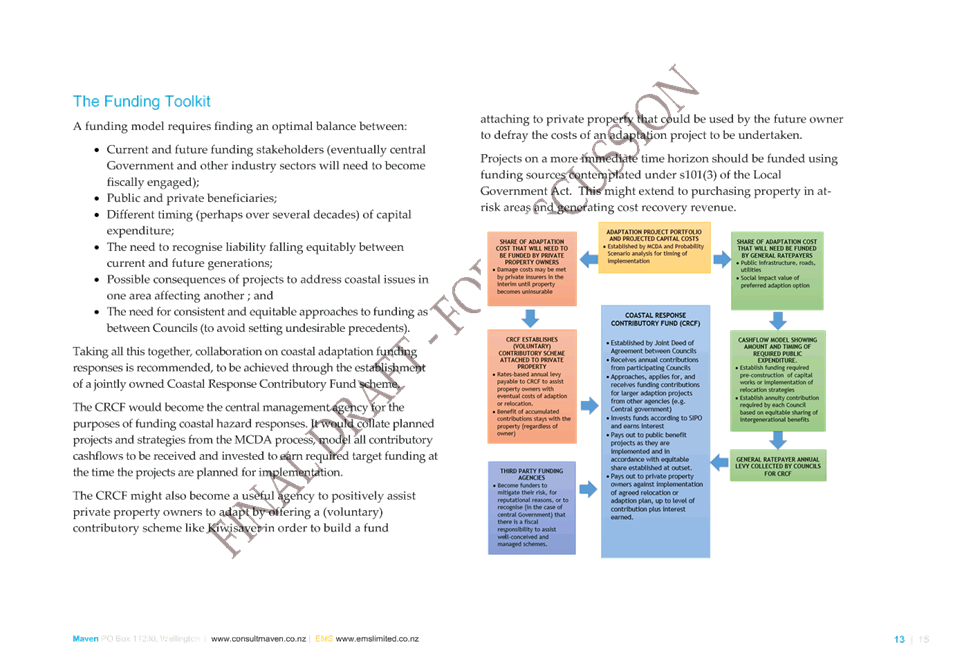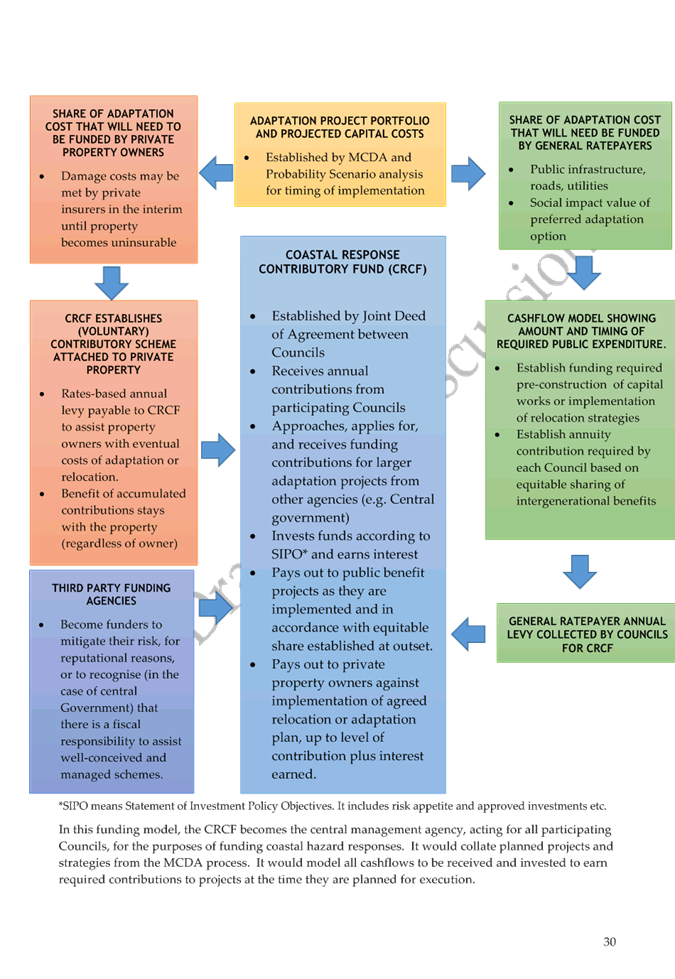Meeting of the
Clifton to Tangoio Coastal Hazards Strategy Joint
Committee
Date: Friday 19 August 2016
Time: 10.00 am
|
Venue:
|
Council Chamber
Hawke's Bay Regional Council
159 Dalton Street
NAPIER
|
Agenda
Item Subject Page
1. Welcome
/ Apologies
2. Conflict
of Interest Declarations
3. Confirmation of
Minutes of the Clifton to Tangoio Coastal Hazards Strategy Joint Committee held
on 2 May 2016
4. Matters Arising
from Minutes of the Clifton to Tangoio Coastal Hazards Strategy Joint Committee
held on 2 May 2016
5. Stage 2: Draft
Decision Making Framework 3
6. Stage 2: Funding
Model 37
7. Ground Water and
Sea Level Rise – Hazard Assessment 91
8. Project Manager
Update 95
9. Communications
Update 99
10. Update of Protection Works at
Whakarire Avenue 101
11. Update on Proposed Revetment
Works at Clifton 103
12. Other Matters for discussion
Clifton to Tangoio Coastal Hazards
Strategy Joint Committee
Friday 19 August 2016
Subject: Stage 2: Draft Decision
Making Framework
Reason for Report
1. This report
presents a draft Stage 2 Decision Making Framework prepared by Stephen Daysh
from EMS (attached).
Discussion
2. The attached
report has been prepared as part of the Stage Two work undertaken by Maven
Consulting (Wayne Mills) and EMS (Stephen Daysh) dealing with a funding model
for coastal hazard responses and a decision making framework respectively.
3. The decision
making framework is required to turn what we now know about coastal hazards
risks (as confirmed in Stage 1) into actionable responses.
4. Originally, the
intention was to present a proposed decision making framework to this meeting for
adoption. However, TAG have taken the view that presenting Mr Daysh’s
report as a draft at today’s meeting is the preferred approach, for the
following reasons:
4.1. The draft
report includes a range of important principles which TAG would like to confirm
with the Joint Committee before finalising the proposed decision making
framework, and in particular feedback is sought on the proposed recommendations
in Section 4.0 of the report; and
4.2. TAG have
recently been approached by the Living at the Edge team (refer to the Project
Managers report provided as Item 8 in this agenda for further
information) to identify ways in which their work may be integrated into, and
benefit, the Strategy. While a late development, there is significant potential
value, particularly for Stage 2 and Stage 3, and TAG felt it prudent to provide
scope for any learnings or proposals from the Living at the Edge team to be
incorporated into the methodology for the Stage 2 decision making framework.
5. In
today’s meeting, TAG seeks an agreement from the Joint Committee to the
principles and recommendations outlined in the draft report and direction on a
range of key questions which will be presented by Mr Daysh. Support is also
sought for TAG to consider opportunities to integrate input from the Living at
the Edge team into the draft decision making framework.
6. Finally, TAG
notes that a Stage 3 Implementation Plan is required to support the decision
making framework. This will be developed by TAG to outline the logistics,
process details, timing and resourcing to roll out the final decision making
framework as a Stage 3 work programme. This, together with the final decision
making framework, will be presented for adoption to the next Joint Committee
meeting in December 2016.
|
Recommendations
That the Clifton to Tangoio Coastal Hazards Strategy Joint
Committee:
1. Receives the draft report ‘Clifton
to Tangoio Coastal Hazards Strategy 2120 Stage Two Report: Decision Making
Framework’.
2. Supports TAG to
consider opportunities to collaborate with the Living at the Edge team as
part of finalising the decision making framework.
|
Authored by:
|
Simon Bendall
Project Manager
|
|
Approved by:
|
Mike Adye
Group Manager Asset Management
|
|
Attachment/s
|
1
|
Stage Two
Report: Decision Making Framework
|
|
|
|
Stage
Two Report: Decision Making Framework
|
Attachment 1
|
































Clifton to Tangoio Coastal Hazards
Strategy Joint Committee
Friday 19 August 2016
Subject: Stage 2: Funding Model
Reason for Report
1. This report
seeks a resolution from the Joint Committee to endorse the proposed Stage 2
Funding Model prepared by Wayne Mills from Maven (attached) and to
recommend that the partner Council’s adopt the recommendations provided
in that report.
Discussion
2. The attached
report has been prepared as part of the Stage Two work undertaken by Maven
Consulting (Wayne Mills) and EMS (Stephen Daysh) dealing with a Funding Model
for Coastal Hazard Response and Multi-Criteria Decision Analysis methodology
respectively.
3. The funding
model is required to guide funding processes for responses to coastal hazards
risks, once these responses are identified as part of Stage 3.
4. The report is
provided in two parts – the first being a descriptive summary and
recommendations for general use, while Part Two provides a more detailed
analysis of the funding approach and rationale behind it.
5. The funding
model has been developed in a consultative manner, including:
5.1. The
circulation of a first draft to TAG for review and feedback;
5.2. A workshop
with the Joint Committee on key concepts and approaches;
5.3. A workshop
with senior council executives (principally financial controllers and asset
managers) and TAG to explore any implementation matters associated with the proposed
model; and
6. In addition,
discussions have taken place with a range of external parties, including staff
from other regional councils, insurance companies, government agencies and
others as part of the information gathering exercise undertaken in the
development of the report.
7. Given that the
Joint Committee does not have the delegation to adopt the proposed funding
model on behalf of the partner Councils, a recommendation is sought from
today’s meeting, in order that members of TAG may present the proposed
model and the series of recommendations it provides to each Council
individually for adoption.
8. In aide of this
process, TAG have called a workshop with all Councillors from the partner
Councils on 29 August, 2016. This workshop will be used as a lead in to
individual Council reporting and decision making.
9. Mr Mills will
be present at today’s meeting to introduce his final report and respond
to questions from the Joint Committee.
|
Recommendations
1. That the Clifton to Tangoio Coastal Hazards
Strategy Joint Committee endorses the report ‘Stage Two –
Development of Funding Model and Guideline, 19 August 2016’ and
recommends that the following recommendations from Part One of that report be
adopted by the Hawke’s Bay Regional Council, Hastings District Council
and Napier City Council:
That the partner Councils:
Recommendation
One
Advocate for, and be
part of, a Local Government Risk Agency-led forum to develop a public /
private sector fiscal response to coastal adaptation caused by sea-level
rise.
Recommendation
Two
Adopt the principle
of a collaborative approach between the partner Councils to future funding
solutions for coastal hazard resilience projects, based on a
whole-of-coastline perspective.
Recommendation
Three
Endorse the concept
of a Coastal Response Contributory Fund (CRCF) and request Council senior
management to develop a draft Heads of Agreement for Councils to consider,
covering matters including (but not limited to) governance, objectives,
ring-fencing of funding, and future scope of operation.
Recommendation
Four
Recognise that
social impact on coastal communities arising from coastal resilience projects
requires robust consultation, systematic identification of potential
outcomes, and measurement of impact using recognised financial proxy
methodologies and endorse the adoption of such an approach in future hazard
evaluation.
Recommendation
Five
Endorse the concept
that the CRCF will, amongst other roles, co-ordinate detailed future
applications and approaches to central government for fiscal assistance on
specific projects.
Recommendation
Six
Support in principle
that larger infrastructure projects should be funded using debt instruments
that broadly match the longer lifespan and intergenerational benefit of such
projects in preference to relying on current ratepayers.
Recommendation
Seven
Investigate the
issue of long term resilience bonds that might be purchased by institutional
investors who have a direct interest in coastal hazard management
|
Authored by:
|
Simon Bendall
Project Manager
|
|
Approved by:
|
Mike Adye
Group Manager Asset Management
|
|
Attachment/s
|
1
|
Part One:
Summary Report and Recommendations
|
|
|
|
2
|
Part Two:
Main Report
|
|
|
|
Part
One: Summary Report and Recommendations
|
Attachment 1
|















|
Part Two: Main Report
|
Attachment 2
|

































|
Part
Two: Main Report
|
Attachment 2
|


Clifton to Tangoio Coastal Hazards
Strategy Joint Committee
Friday 19 August 2016
Subject: Ground Water and Sea
Level Rise – Hazard Assessment
Reason for Report
1. This report updates the Joint Committee on the potential impacts of
sea level rise on coastal groundwater, within the context of work being
undertaken as part of the Clifton to Tangoio Coastal Hazards Strategy 2120 (the
Strategy).
Background
2. The Strategy covers the period 2016-2120 and aims to provide a
framework to guide and direct the assessment and implementation of preferred
options for the long term management of coastal hazards risks between Clifton
and Tangoio.
3. In late 2014 the Joint Committee confirmed the scope of the Strategy
to assess the following coastal hazards risks:
3.1. Coastal erosion (Storm cut, trends, effects of sea level risk)
3.2. Coastal inundation (wave set-up, run-up, overtopping and sea level
risk); and
3.3. Tsunami.
4. At a workshop hosted by the Technical Advisory Group (TAG) in April
2016 for all Councillors from the Partner Councils, a question was raised
regarding whether any consideration had been given to the adverse effects of
sea level rise on ground water along coastal margins.
5. More specifically, the question focused on whether or not the effect
of sea level rise on ground water levels would exacerbate existing hazards
(e.g. surface flooding) or cause new hazards (e.g. groundwater inundation) in
coastal areas, and if so, whether this should be factored in to decision making
as part of Stage 3 of the Strategy.
Groundwater and sea level
6. Groundwater is water held underground in the soil or in pores and
crevices in rock. As sea levels rise, groundwater levels in coastal areas may
also rise in response to hydraulic pressure from the sea. This can result in
wet and soft near surface soils, although this is more problematic for silt and
clay type soils due to capillary action than it is for sand and gravel type
soils.
7. Additionally, rising groundwater could result in a range of impacts
such as:
· Saline intrusion into the aquifer system
· Near surface saline water could affect terrestrial vegetation on the
coast and cause corrosion to underground assets
· Increased risk of liquefaction
· Increased uplift on buildings with sealed basements, possibly
requiring strengthening of these structures
· Underground tanks and services could start to ‘float’.
This is particularly likely to impact large lightweight pipes (such as gas
pipes) and fuel tanks
· Possible water infiltration to basement structures, requiring
waterproofing and pumping
· A possible increase in landslide risk in some locations
Strategy scope
8. As noted above, following discussion and advice from TAG, Strategy
scope was confirmed by the Joint Committee in late 2014. Reports commissioned
by TAG to assess coastal hazards risks under the Strategy did therefore not
specifically include groundwater effects, and were limited to considering
coastal erosion, coastal inundation and tsunami.
9. In responding to the question posed at the Councillor workshop, TAG
needed to determine whether or not the scope of the Strategy should be expanded
at this time. The following factors were considered relevant in making this
assessment:
9.1. Noting community expectations around timeframes, whether or not information
or data on ground water effects was readily available in a form that could be
integrated into the Strategy without significant delay;
9.2. Whether or not this information, if it were available, could
materially alter decisions made in Stage 3 of the Strategy; and
9.3. The degree of risk associated with ground water effects of this
nature
10. In
considering these factors, TAG have determined that:
10.1. While
there is work underway in this area (for example, by GNS Science and HBRC),
there is insufficient data currently available to integrate with the Strategy
at this time.
10.2. Halting
the Strategy to either wait for this data to become available, or to engage
dedicated technical experts to assess these risks, presents issues around cost,
duplication of work, and/or potentially significant delays in Strategy
development
10.3. Given
that many areas along the coast are already pumping ground water, this issue is
already present to a degree, and is not expected to rapidly deteriorate in the
short to medium term.
10.4. It is
considered unlikely that decisions made in Stage 3 would be materially
different were detailed information on this issue made available. For example,
a decision to defend the coast from coastal erosion is unlikely to be influenced
by groundwater issues in the short to medium term.
10.5. It is
anticipated that future iterations of the Strategy as developed through
subsequent reviews will be able to integrate information on groundwater
effects, along with updated and revised science and data as this evolves over
the coming decades.
11. In light
of the above, it is considered that groundwater effects should not be added to
Strategy scope at this time. However, TAG will remain actively involved with
the work being undertaken in this area, and considers that once reliable data
is available it should be factored in to Strategy scope as part of future
review processes.
|
Recommendations
1. That the Clifton to Tangoio Coastal Hazards Strategy Joint Committee
receives and notes the Ground Water and Sea Level Rise – Hazard
Assessment report.
2. That the Clifton to Tangoio Coastal Hazards
Strategy Joint Committee notes that the impact of sea level rise on
groundwater levels and associated effects should be incorporated into future
reviews of the Strategy.
|
Authored by:
|
Simon Bendall
Project Manager
|
|
Approved by:
|
Mike Adye
Group Manager Asset Management
|
|
Attachment/s
There are no
attachments for this report.
Clifton
to Tangoio Coastal Hazards Strategy Joint Committee
Friday 19 August 2016
Subject: Project Manager Update
Reason for Report
1. This report provides an opportunity for the Project Manager to
present an update to the Committee and answer any questions on general project
matters.
Timeframe and Budget Update
2. There have been some adjustments to project timeframes to account
for additional consultation and analysis in the development of Stage 2, which
has proved to be a highly complicated phase of Strategy development, however
the budget allocation for Stage 2 is on track.
3. The following outlines key dates over the coming months and an
indication of programme through to the completion of Stage 3.
|
19 August, 2016
|
· Joint
Committee Meeting:
- Confirm direction on Decision Making Framework
- Confirm recommendation to Partner Councils on Funding Model
|
|
29 August, 2016
|
· TAG
Meeting
· Councillor
Workshop:
- Present Funding Model recommendations
|
|
During September 2016
|
· Funding
Model recommendations presented to Partner Councils for adoption
|
|
19 September, 2016
|
· TAG
Meeting
|
|
7 October
|
· Workshop
– TAG, T&T, EMS, and Living at the Edge, to determine programme of
work, resource requirements etc for Stage 3.
|
|
November – December 2016
|
· Form
Stage 3 Assessment Panels
|
|
5 December 2016
|
· Joint
Committee Meeting:
- Adopt process for Stage 3
|
|
February 2017 – August 2017 (approx.)
|
· Assessment
Panel Process
|
|
September 2017
|
· Joint
Committee receives recommendations from Assessment Panels
|
Living at the Edge
4. Living at the Edge is a work stream under the resilient Communities
Science Challenge. The team working on this work stream is keen to work
with the Coastal Strategy Team and can add value to the process.
5. In recent weeks’ members of TAG have held a number of meetings
with the Living at the Edge team to discuss and consider ways in which their
work can integrate with and benefit the development of the Coastal Hazards
Strategy.
6. This culminated in a meeting with 4 members of the Living at the
Edge team and TAG on 8 August. It was agreed that there is significant
potential for mutual benefit through integrating these projects, but that this
needed to be carefully planned to avoid duplication, complication and confusing
messaging for stakeholders and communities.
7. A full day workshop has been confirmed with TAG, Tonkin and Taylor,
Environmental Management Services, Maven Consulting and Living at the Edge on 7
October, 2016 to map out the programme of work for Stage 3. A report on the
outcome of this process will be provided to the Joint Committee at the next
meeting in December.
8. To provide additional background information, attached to this paper
is a brief summary document on the Living at the Edge project.
|
Recommendation
1. That the Clifton to Tangoio Coastal Hazards
Strategy Joint Committee receives and notes the Project
Manager Update report.
|
Authored by:
|
Simon Bendall
Project Manager
|
|
Approved by:
|
Mike Adye
Group Manager Asset Management
|
|
Attachment/s
|
1
|
Living at the
Edge Transforming the Margins Overview
|
|
|
|
Living
at the Edge Transforming the Margins Overview
|
Attachment 1
|


Clifton to Tangoio Coastal Hazards
Strategy Joint Committee
Friday 19 August 2016
Subject: Communications Update
Reason for Report
1. This report provides an update on communications and consultation
undertaken since the last Joint Committee meeting in May.
Discussion
Communicating Stage
One
2. Following the confirmation and adoption of Stage One at the May
Joint Committee meeting, TAG implemented a range of communications to ensure
that the new information on hazard extents and risks was well distributed and
understood.
3. This commenced with a mail out in mid-May 2016 to all landowners
within the new hazard extents for coastal erosion and inundation, with just
over 2,000 letters being sent. The mail out was clustered into 6 coastal areas,
with each cluster receiving a summary sheet relevant to their area. The
following indicates the numbers of letters sent for each cluster:
3.1. Tangoio / Whirinaki: 187
3.2. Bay View: 131
3.3. Westshore: 686
3.4. Marine Parade: 30
3.5. Clive / East Clive: 380
3.6. Haumoana / Te Awanga / Clifton: 641
4. In addition to the summary sheet, the letters also included a link
to the updated project website (www.hbcoast.co.nz)
and an invitation to attend a drop in session being held in Westshore and Te
Awanga. The drop in sessions were also advertised in local media.
5. The drop in sessions were hosted by TAG on the 1st and 2nd
of June in Westshore and Te Awanga respectively. Both were well attended, with
approximately 60 people attending each session. TAG considers that the format
of the sessions worked well, that they were well received, and that there was a
good level of engagement by attendees.
6. As a result of the mail out and drop in sessions, 153 people signed
up to join the Strategy’s mailing list. While customer services staff at
each of the Councils were briefed and advised that there could be a spike in
queries following the mail out, this didn’t eventuate.
7. It is also noted that following the May Joint Committee meeting, LIM
staff from each of the Councils were advised of the new hazards information and
this is now being reflected on new LIM requests for properties within the new
hazards extents.
Engaging with Marae
8. There are 7 marae within the Strategy area: Tangoio, Petane, Pukemokimoki,
Waiohiki, Matahiwi, Kohupatiki and Ruahapia.
9. Each of these marae have been contacted by the Chair to update them
on Strategy development and in some cases meetings have been held.
10. As a
follow up to this contact, letters were sent to all Marae Chairs on 13 June,
2016. The letters provided maps relevant to each marae, showing the new hazards
extents and the information collected to date on elements at risk (e.g.
cultural sites, schools, etc). It was asked whether or not there were additional
culturally significant areas or sites not shown on the maps that should be
considered as part of the Strategy. Follow up phone calls have been made
subsequent to this letter being sent and these communications will continue. No
new information on elements at risk has been received to date.
Website
11. 2,842
individual users visited the updated project website (www.hbcoast.co.nz) since the last Joint
Committee meeting in May 2016.
12. A revised
/ simplified mapping tool for hazards extents will shortly be available through
the website.
Future communications
13. TAG is
conscious that following this meeting, there will be a period of limited public
activity in terms of the Strategy until later in the year. With the support of
Drew Broadley from HBRC, additional communications will be developed over the
coming weeks to maintain a public presence for the Strategy and to provide
updates on progress.
Insurance industry
14. Communication
with the insurance industry is ongoing. HBRC are hosting a discussion
with the Insurance Council on 1st September. Further contact
with both the Council and individual insurance companies is planned for the
future.
|
Recommendation
1. That the Clifton to Tangoio Coastal Hazards Strategy Joint Committee
receives and notes the Communications Update report.
|
Authored by:
|
Simon Bendall
Project Manager
|
|
Approved by:
|
Mike Adye
Group Manager Asset Management
|
|
Attachment/s
There are no
attachments for this report.
Clifton
to Tangoio Coastal Hazards Strategy Joint Committee
Friday 19 August 2016
Subject: Update of Protection
Works at Whakarire Avenue
1. This report provides an opportunity for Napier City Council staff to
update the Joint Committee on progress with the protection works at Whakarire
Avenue.
2. Napier City Council staff will provide a verbal update at the
meeting.
|
Recommendation:
1. That the Clifton to Tangoio Coastal Hazards
Strategy Joint Committee receives and notes the verbal Update of
Protection Works at Whakarire Avenue report.
|
Authored by:
|
Simon Bendall
Project Manager
|
|
Approved by:
|
Mike Adye
Group Manager Asset Management
|
|
Attachment/s
There are no
attachments for this report.
Clifton
to Tangoio Coastal Hazards Strategy Joint Committee
Friday 19 August 2016
Subject: Update on Proposed
Revetment Works at Clifton
1. This report provides an opportunity for Hastings District Council
staff to update the Joint Committee on proposed revetment works at Clifton.
2. Hastings District Council staff will provide a verbal update at the
meeting.
|
Recommendation
1. That the Clifton to Tangoio Coastal Hazards
Strategy Joint Committee receives and notes the verbal Update on
Proposed Revetment Works at Clifton report.
|
Authored by:
|
Simon Bendall
Project Manager
|
|
Approved by:
|
Mike Adye
Group Manager Asset Management
|
|
Attachment/s
There are no
attachments for this report.




















































































